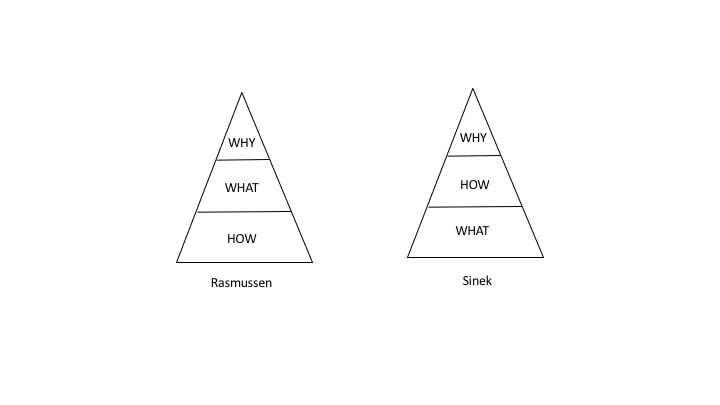I just finished Simon Sinek's (2009) "Start with Why." I was struck by the similarities between Sinek's 'Golden Circle' and Jens Rasmussen's 'Abstraction Hierarchy' (see figure). Both parse systems in terms of a hierarchical association between why, what, and how.

For Rasmussen - 'what' represented the level of the system being attended; 'why' represented a higher-level of abstraction that reflected the significance of the 'what' relative to the whole system; with the highest level of abstraction reflecting the ultimate WHY of a system - its purpose. In Rasmussen's system, 'how' represented a more concrete description of significant components of the level being attended (e.g., the component processes serving the 'what' level above).
Sinek's 'why' corresponds with the pinnacle of Rasmussen's Abstraction Hiearchy. It represents the ultimate purpose of the system. However, Sinek reverses Rasmussen's 'what' and 'how.' For Sinek, 'how' represents the processes serving the 'why;' and the 'what' represents the products of these processes.
Although I have been teaching Rasmussen's approach to Cognitive Systems Engineering (CSE) for over 30 years, I think that Sinek's WHY-HOW-WHAT partitioning conforms more naturally with common usage of the terms 'how' and 'what.' So, I think this is a pedagogical improvement on Rasmussen's framework.
However, I found that the overall gist of Sinek's "Start with Why" reinforced many of the central themes of CSE. That is, for a 'cognitive system' the purpose (i.e., the WHY) sets the ultimate context for parsing the system (e.g., processes and objects) into meaningful components. This is an important contrast to classical (objective) scientific approaches to physical systems. Classical scientific approaches have dismissed the 'why' as subjective! The 'why' reflected the 'biases' of observers. But for a cognitive science, the observers are the objects of study!
Thus, cognitive science and cognitive engineering must always start with WHY!
